Strategies for Health Workforce Planning in North Korea: A Report
VerifiedAdded on 2023/06/11
|14
|3277
|393
Report
AI Summary
This report provides a comprehensive analysis of health workforce planning in North Korea, a low-income country facing significant political and social challenges that impact its healthcare system. The study uses the STEEP model to assess social, technological, economic, environmental, and political factors affecting the health workforce. It presents a data profile of healthcare workers, identifies critical issues such as recruitment, retention, and resource distribution, and proposes strategies for implementation, including a five-year plan to address workforce gaps and improve healthcare service delivery. The report emphasizes the need for effective workforce training, technological interventions, and international cooperation to enhance the quality and accessibility of healthcare in North Korea. Desklib provides this document as a resource for students studying public health and health policy.
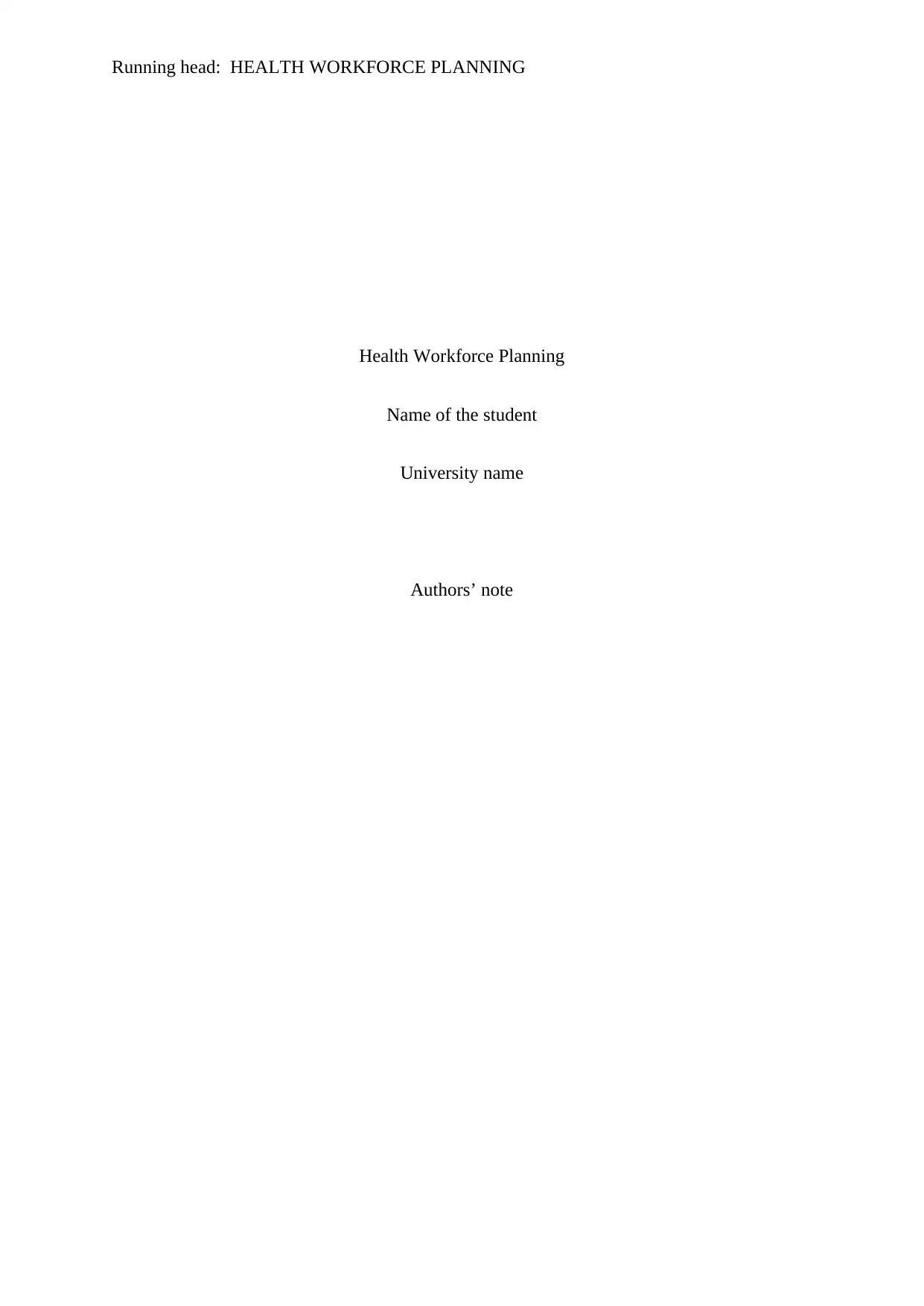
Running head: HEALTH WORKFORCE PLANNING
Health Workforce Planning
Name of the student
University name
Authors’ note
Health Workforce Planning
Name of the student
University name
Authors’ note
Paraphrase This Document
Need a fresh take? Get an instant paraphrase of this document with our AI Paraphraser
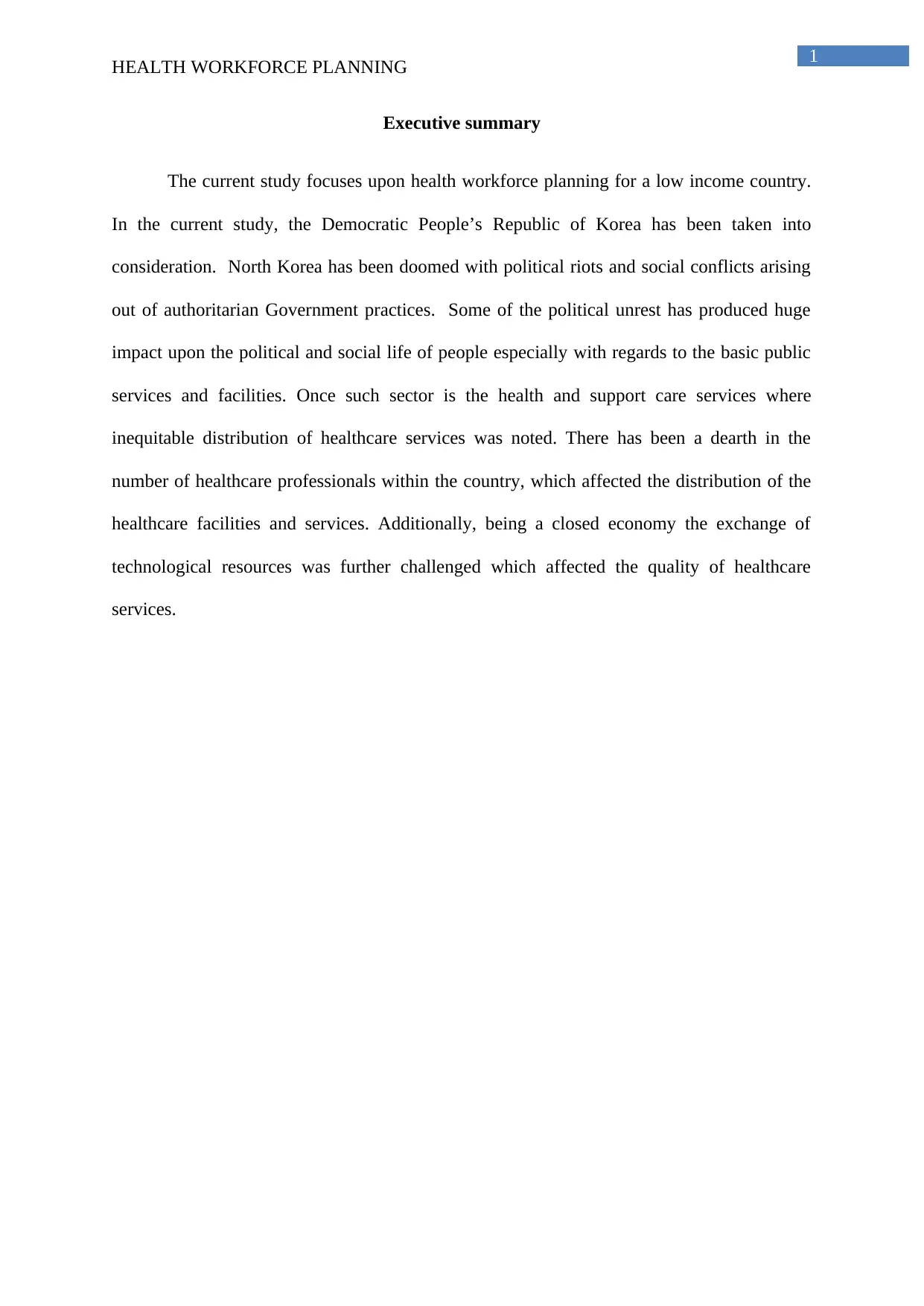
1
HEALTH WORKFORCE PLANNING
Executive summary
The current study focuses upon health workforce planning for a low income country.
In the current study, the Democratic People’s Republic of Korea has been taken into
consideration. North Korea has been doomed with political riots and social conflicts arising
out of authoritarian Government practices. Some of the political unrest has produced huge
impact upon the political and social life of people especially with regards to the basic public
services and facilities. Once such sector is the health and support care services where
inequitable distribution of healthcare services was noted. There has been a dearth in the
number of healthcare professionals within the country, which affected the distribution of the
healthcare facilities and services. Additionally, being a closed economy the exchange of
technological resources was further challenged which affected the quality of healthcare
services.
HEALTH WORKFORCE PLANNING
Executive summary
The current study focuses upon health workforce planning for a low income country.
In the current study, the Democratic People’s Republic of Korea has been taken into
consideration. North Korea has been doomed with political riots and social conflicts arising
out of authoritarian Government practices. Some of the political unrest has produced huge
impact upon the political and social life of people especially with regards to the basic public
services and facilities. Once such sector is the health and support care services where
inequitable distribution of healthcare services was noted. There has been a dearth in the
number of healthcare professionals within the country, which affected the distribution of the
healthcare facilities and services. Additionally, being a closed economy the exchange of
technological resources was further challenged which affected the quality of healthcare
services.
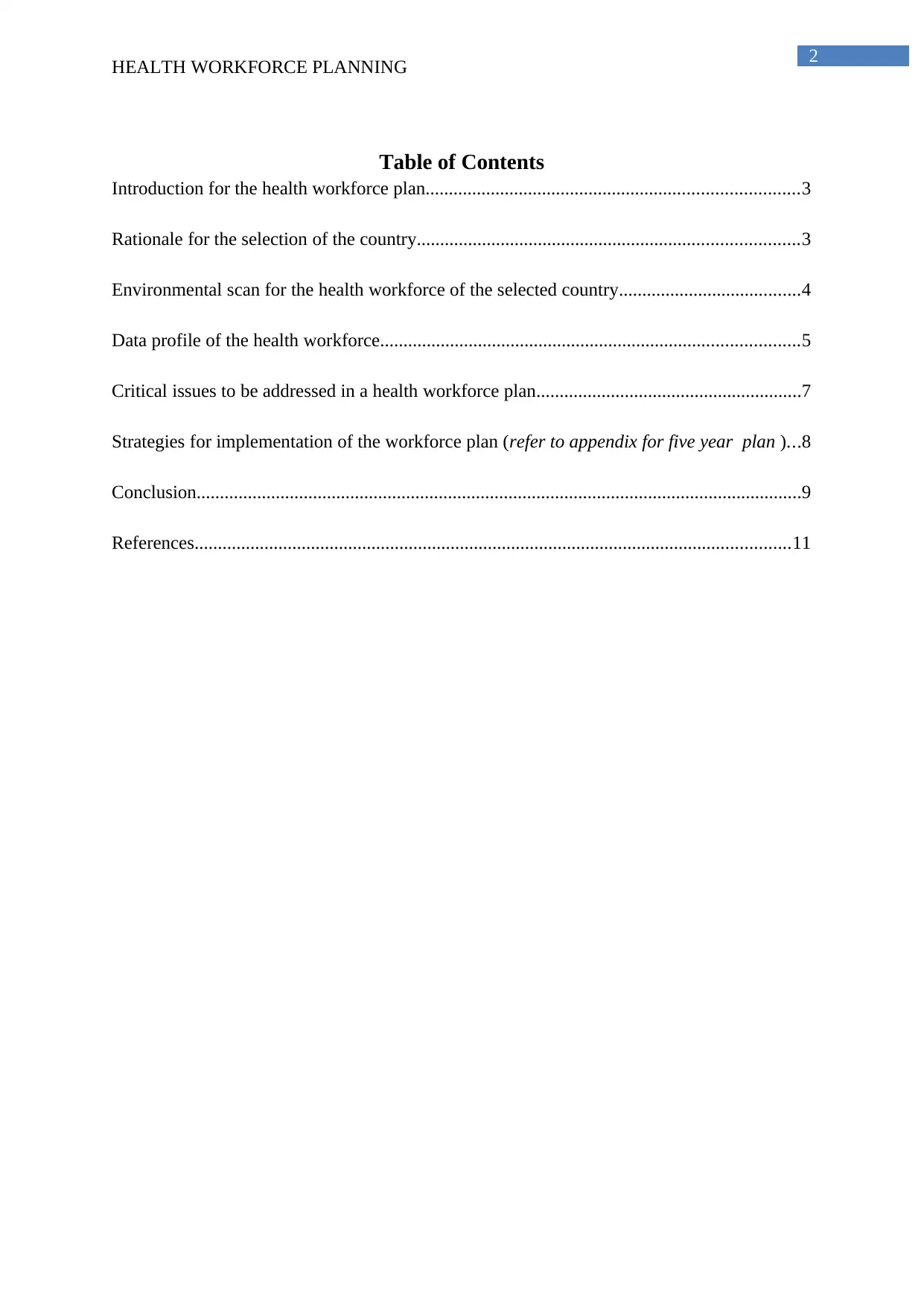
2
HEALTH WORKFORCE PLANNING
Table of Contents
Introduction for the health workforce plan................................................................................3
Rationale for the selection of the country..................................................................................3
Environmental scan for the health workforce of the selected country.......................................4
Data profile of the health workforce..........................................................................................5
Critical issues to be addressed in a health workforce plan.........................................................7
Strategies for implementation of the workforce plan (refer to appendix for five year plan )...8
Conclusion..................................................................................................................................9
References................................................................................................................................11
HEALTH WORKFORCE PLANNING
Table of Contents
Introduction for the health workforce plan................................................................................3
Rationale for the selection of the country..................................................................................3
Environmental scan for the health workforce of the selected country.......................................4
Data profile of the health workforce..........................................................................................5
Critical issues to be addressed in a health workforce plan.........................................................7
Strategies for implementation of the workforce plan (refer to appendix for five year plan )...8
Conclusion..................................................................................................................................9
References................................................................................................................................11
⊘ This is a preview!⊘
Do you want full access?
Subscribe today to unlock all pages.

Trusted by 1+ million students worldwide
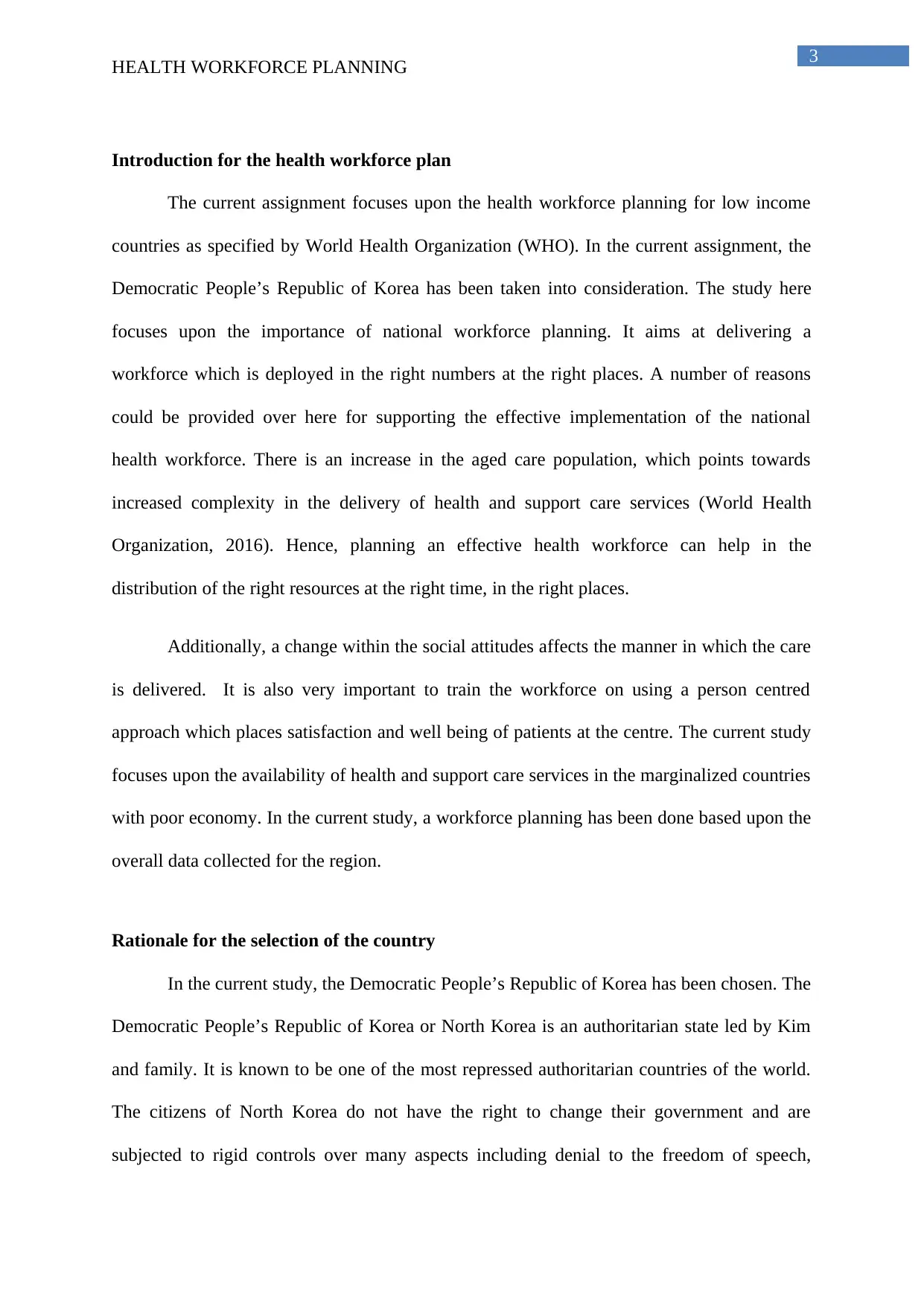
3
HEALTH WORKFORCE PLANNING
Introduction for the health workforce plan
The current assignment focuses upon the health workforce planning for low income
countries as specified by World Health Organization (WHO). In the current assignment, the
Democratic People’s Republic of Korea has been taken into consideration. The study here
focuses upon the importance of national workforce planning. It aims at delivering a
workforce which is deployed in the right numbers at the right places. A number of reasons
could be provided over here for supporting the effective implementation of the national
health workforce. There is an increase in the aged care population, which points towards
increased complexity in the delivery of health and support care services (World Health
Organization, 2016). Hence, planning an effective health workforce can help in the
distribution of the right resources at the right time, in the right places.
Additionally, a change within the social attitudes affects the manner in which the care
is delivered. It is also very important to train the workforce on using a person centred
approach which places satisfaction and well being of patients at the centre. The current study
focuses upon the availability of health and support care services in the marginalized countries
with poor economy. In the current study, a workforce planning has been done based upon the
overall data collected for the region.
Rationale for the selection of the country
In the current study, the Democratic People’s Republic of Korea has been chosen. The
Democratic People’s Republic of Korea or North Korea is an authoritarian state led by Kim
and family. It is known to be one of the most repressed authoritarian countries of the world.
The citizens of North Korea do not have the right to change their government and are
subjected to rigid controls over many aspects including denial to the freedom of speech,
HEALTH WORKFORCE PLANNING
Introduction for the health workforce plan
The current assignment focuses upon the health workforce planning for low income
countries as specified by World Health Organization (WHO). In the current assignment, the
Democratic People’s Republic of Korea has been taken into consideration. The study here
focuses upon the importance of national workforce planning. It aims at delivering a
workforce which is deployed in the right numbers at the right places. A number of reasons
could be provided over here for supporting the effective implementation of the national
health workforce. There is an increase in the aged care population, which points towards
increased complexity in the delivery of health and support care services (World Health
Organization, 2016). Hence, planning an effective health workforce can help in the
distribution of the right resources at the right time, in the right places.
Additionally, a change within the social attitudes affects the manner in which the care
is delivered. It is also very important to train the workforce on using a person centred
approach which places satisfaction and well being of patients at the centre. The current study
focuses upon the availability of health and support care services in the marginalized countries
with poor economy. In the current study, a workforce planning has been done based upon the
overall data collected for the region.
Rationale for the selection of the country
In the current study, the Democratic People’s Republic of Korea has been chosen. The
Democratic People’s Republic of Korea or North Korea is an authoritarian state led by Kim
and family. It is known to be one of the most repressed authoritarian countries of the world.
The citizens of North Korea do not have the right to change their government and are
subjected to rigid controls over many aspects including denial to the freedom of speech,
Paraphrase This Document
Need a fresh take? Get an instant paraphrase of this document with our AI Paraphraser
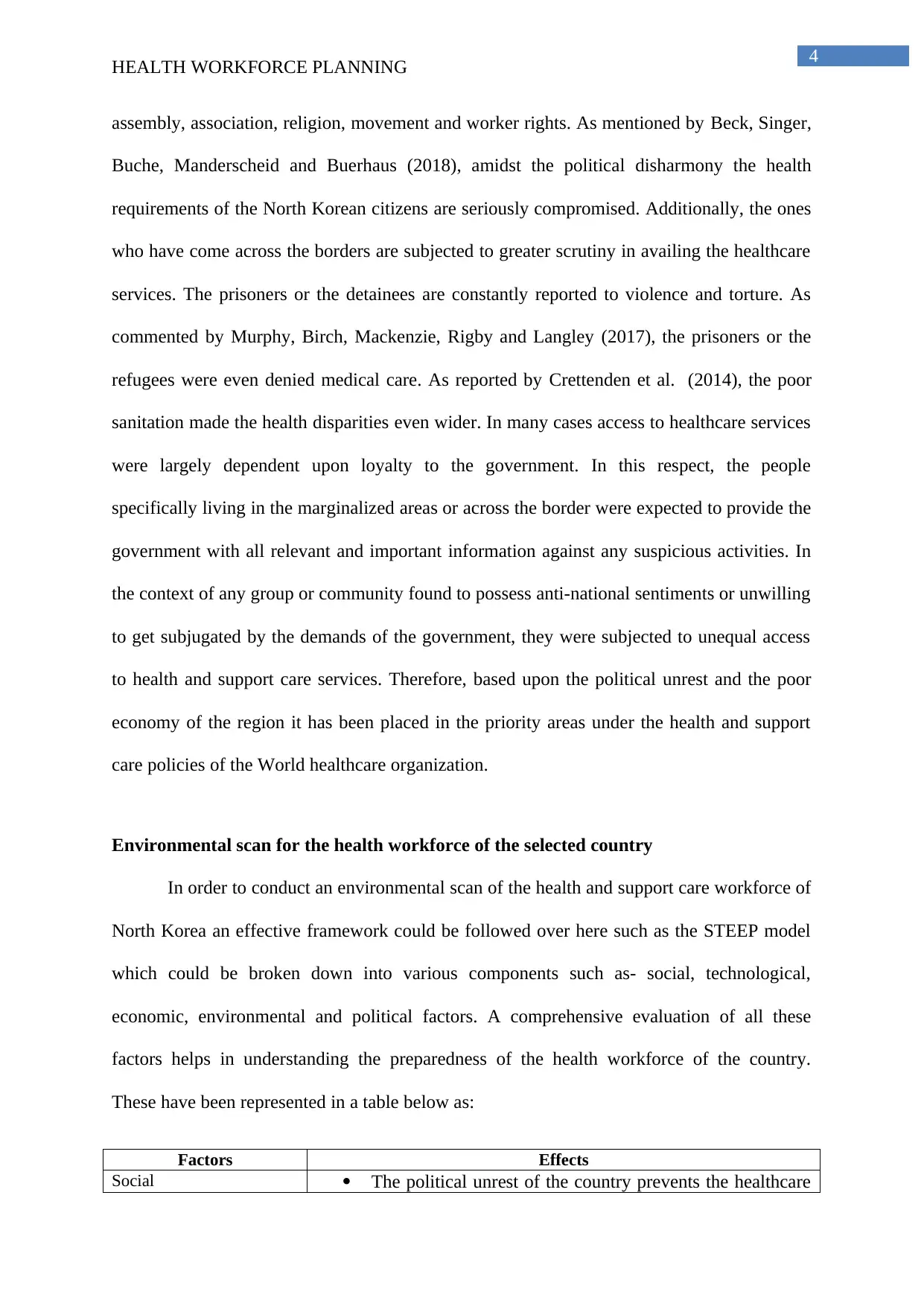
4
HEALTH WORKFORCE PLANNING
assembly, association, religion, movement and worker rights. As mentioned by Beck, Singer,
Buche, Manderscheid and Buerhaus (2018), amidst the political disharmony the health
requirements of the North Korean citizens are seriously compromised. Additionally, the ones
who have come across the borders are subjected to greater scrutiny in availing the healthcare
services. The prisoners or the detainees are constantly reported to violence and torture. As
commented by Murphy, Birch, Mackenzie, Rigby and Langley (2017), the prisoners or the
refugees were even denied medical care. As reported by Crettenden et al. (2014), the poor
sanitation made the health disparities even wider. In many cases access to healthcare services
were largely dependent upon loyalty to the government. In this respect, the people
specifically living in the marginalized areas or across the border were expected to provide the
government with all relevant and important information against any suspicious activities. In
the context of any group or community found to possess anti-national sentiments or unwilling
to get subjugated by the demands of the government, they were subjected to unequal access
to health and support care services. Therefore, based upon the political unrest and the poor
economy of the region it has been placed in the priority areas under the health and support
care policies of the World healthcare organization.
Environmental scan for the health workforce of the selected country
In order to conduct an environmental scan of the health and support care workforce of
North Korea an effective framework could be followed over here such as the STEEP model
which could be broken down into various components such as- social, technological,
economic, environmental and political factors. A comprehensive evaluation of all these
factors helps in understanding the preparedness of the health workforce of the country.
These have been represented in a table below as:
Factors Effects
Social The political unrest of the country prevents the healthcare
HEALTH WORKFORCE PLANNING
assembly, association, religion, movement and worker rights. As mentioned by Beck, Singer,
Buche, Manderscheid and Buerhaus (2018), amidst the political disharmony the health
requirements of the North Korean citizens are seriously compromised. Additionally, the ones
who have come across the borders are subjected to greater scrutiny in availing the healthcare
services. The prisoners or the detainees are constantly reported to violence and torture. As
commented by Murphy, Birch, Mackenzie, Rigby and Langley (2017), the prisoners or the
refugees were even denied medical care. As reported by Crettenden et al. (2014), the poor
sanitation made the health disparities even wider. In many cases access to healthcare services
were largely dependent upon loyalty to the government. In this respect, the people
specifically living in the marginalized areas or across the border were expected to provide the
government with all relevant and important information against any suspicious activities. In
the context of any group or community found to possess anti-national sentiments or unwilling
to get subjugated by the demands of the government, they were subjected to unequal access
to health and support care services. Therefore, based upon the political unrest and the poor
economy of the region it has been placed in the priority areas under the health and support
care policies of the World healthcare organization.
Environmental scan for the health workforce of the selected country
In order to conduct an environmental scan of the health and support care workforce of
North Korea an effective framework could be followed over here such as the STEEP model
which could be broken down into various components such as- social, technological,
economic, environmental and political factors. A comprehensive evaluation of all these
factors helps in understanding the preparedness of the health workforce of the country.
These have been represented in a table below as:
Factors Effects
Social The political unrest of the country prevents the healthcare
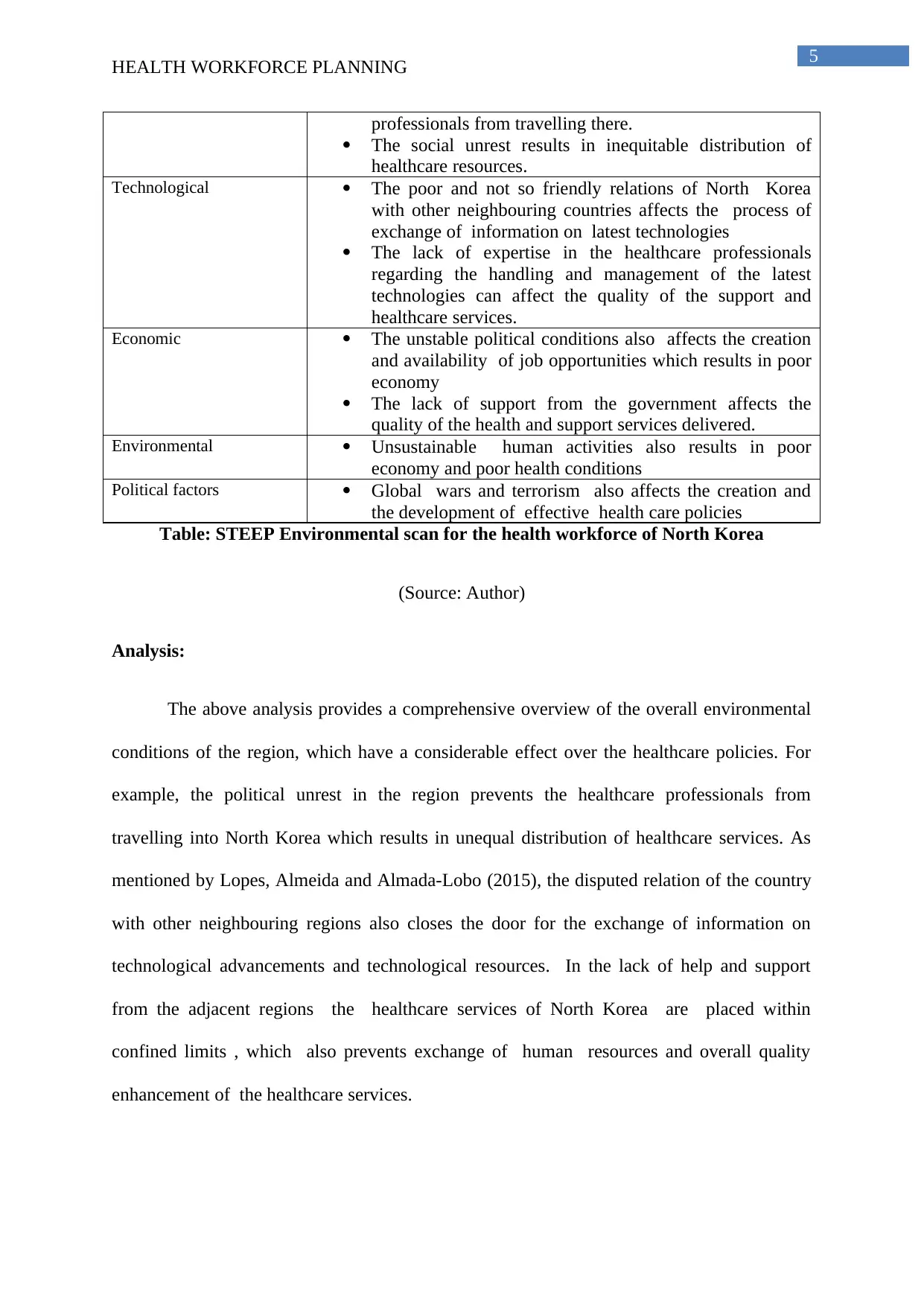
5
HEALTH WORKFORCE PLANNING
professionals from travelling there.
The social unrest results in inequitable distribution of
healthcare resources.
Technological The poor and not so friendly relations of North Korea
with other neighbouring countries affects the process of
exchange of information on latest technologies
The lack of expertise in the healthcare professionals
regarding the handling and management of the latest
technologies can affect the quality of the support and
healthcare services.
Economic The unstable political conditions also affects the creation
and availability of job opportunities which results in poor
economy
The lack of support from the government affects the
quality of the health and support services delivered.
Environmental Unsustainable human activities also results in poor
economy and poor health conditions
Political factors Global wars and terrorism also affects the creation and
the development of effective health care policies
Table: STEEP Environmental scan for the health workforce of North Korea
(Source: Author)
Analysis:
The above analysis provides a comprehensive overview of the overall environmental
conditions of the region, which have a considerable effect over the healthcare policies. For
example, the political unrest in the region prevents the healthcare professionals from
travelling into North Korea which results in unequal distribution of healthcare services. As
mentioned by Lopes, Almeida and Almada-Lobo (2015), the disputed relation of the country
with other neighbouring regions also closes the door for the exchange of information on
technological advancements and technological resources. In the lack of help and support
from the adjacent regions the healthcare services of North Korea are placed within
confined limits , which also prevents exchange of human resources and overall quality
enhancement of the healthcare services.
HEALTH WORKFORCE PLANNING
professionals from travelling there.
The social unrest results in inequitable distribution of
healthcare resources.
Technological The poor and not so friendly relations of North Korea
with other neighbouring countries affects the process of
exchange of information on latest technologies
The lack of expertise in the healthcare professionals
regarding the handling and management of the latest
technologies can affect the quality of the support and
healthcare services.
Economic The unstable political conditions also affects the creation
and availability of job opportunities which results in poor
economy
The lack of support from the government affects the
quality of the health and support services delivered.
Environmental Unsustainable human activities also results in poor
economy and poor health conditions
Political factors Global wars and terrorism also affects the creation and
the development of effective health care policies
Table: STEEP Environmental scan for the health workforce of North Korea
(Source: Author)
Analysis:
The above analysis provides a comprehensive overview of the overall environmental
conditions of the region, which have a considerable effect over the healthcare policies. For
example, the political unrest in the region prevents the healthcare professionals from
travelling into North Korea which results in unequal distribution of healthcare services. As
mentioned by Lopes, Almeida and Almada-Lobo (2015), the disputed relation of the country
with other neighbouring regions also closes the door for the exchange of information on
technological advancements and technological resources. In the lack of help and support
from the adjacent regions the healthcare services of North Korea are placed within
confined limits , which also prevents exchange of human resources and overall quality
enhancement of the healthcare services.
⊘ This is a preview!⊘
Do you want full access?
Subscribe today to unlock all pages.

Trusted by 1+ million students worldwide
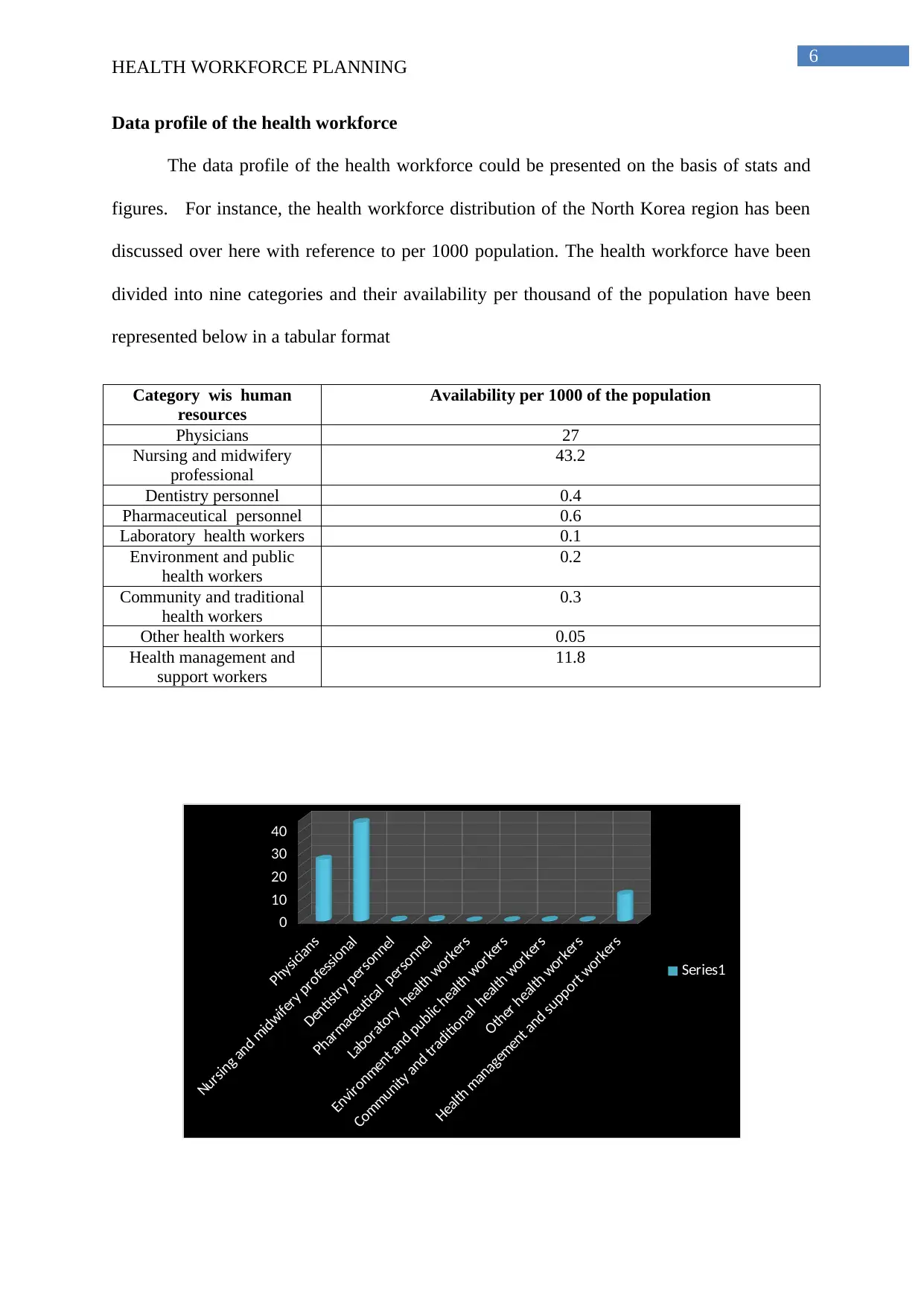
6
HEALTH WORKFORCE PLANNING
Data profile of the health workforce
The data profile of the health workforce could be presented on the basis of stats and
figures. For instance, the health workforce distribution of the North Korea region has been
discussed over here with reference to per 1000 population. The health workforce have been
divided into nine categories and their availability per thousand of the population have been
represented below in a tabular format
Category wis human
resources
Availability per 1000 of the population
Physicians 27
Nursing and midwifery
professional
43.2
Dentistry personnel 0.4
Pharmaceutical personnel 0.6
Laboratory health workers 0.1
Environment and public
health workers
0.2
Community and traditional
health workers
0.3
Other health workers 0.05
Health management and
support workers
11.8
Physicians
Nursing and midwifery professional
Dentistry personnel
Pharmaceutical personnel
Laboratory health workers
Environment and public health workers
Community and traditional health workers
Other health workers
Health management and support workers
0
10
20
30
40
Series1
HEALTH WORKFORCE PLANNING
Data profile of the health workforce
The data profile of the health workforce could be presented on the basis of stats and
figures. For instance, the health workforce distribution of the North Korea region has been
discussed over here with reference to per 1000 population. The health workforce have been
divided into nine categories and their availability per thousand of the population have been
represented below in a tabular format
Category wis human
resources
Availability per 1000 of the population
Physicians 27
Nursing and midwifery
professional
43.2
Dentistry personnel 0.4
Pharmaceutical personnel 0.6
Laboratory health workers 0.1
Environment and public
health workers
0.2
Community and traditional
health workers
0.3
Other health workers 0.05
Health management and
support workers
11.8
Physicians
Nursing and midwifery professional
Dentistry personnel
Pharmaceutical personnel
Laboratory health workers
Environment and public health workers
Community and traditional health workers
Other health workers
Health management and support workers
0
10
20
30
40
Series1
Paraphrase This Document
Need a fresh take? Get an instant paraphrase of this document with our AI Paraphraser
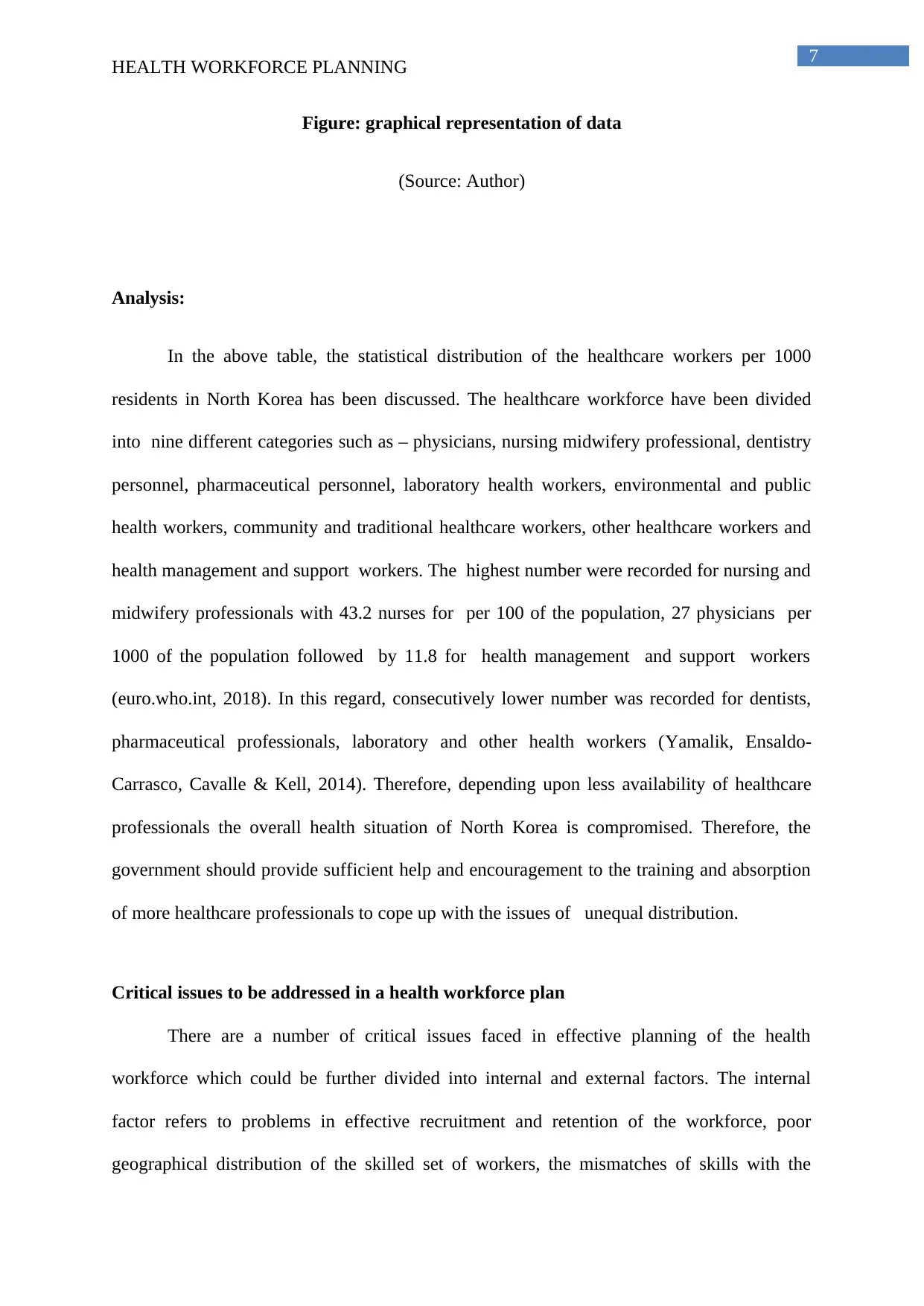
7
HEALTH WORKFORCE PLANNING
Figure: graphical representation of data
(Source: Author)
Analysis:
In the above table, the statistical distribution of the healthcare workers per 1000
residents in North Korea has been discussed. The healthcare workforce have been divided
into nine different categories such as – physicians, nursing midwifery professional, dentistry
personnel, pharmaceutical personnel, laboratory health workers, environmental and public
health workers, community and traditional healthcare workers, other healthcare workers and
health management and support workers. The highest number were recorded for nursing and
midwifery professionals with 43.2 nurses for per 100 of the population, 27 physicians per
1000 of the population followed by 11.8 for health management and support workers
(euro.who.int, 2018). In this regard, consecutively lower number was recorded for dentists,
pharmaceutical professionals, laboratory and other health workers (Yamalik, Ensaldo‐
Carrasco, Cavalle & Kell, 2014). Therefore, depending upon less availability of healthcare
professionals the overall health situation of North Korea is compromised. Therefore, the
government should provide sufficient help and encouragement to the training and absorption
of more healthcare professionals to cope up with the issues of unequal distribution.
Critical issues to be addressed in a health workforce plan
There are a number of critical issues faced in effective planning of the health
workforce which could be further divided into internal and external factors. The internal
factor refers to problems in effective recruitment and retention of the workforce, poor
geographical distribution of the skilled set of workers, the mismatches of skills with the
HEALTH WORKFORCE PLANNING
Figure: graphical representation of data
(Source: Author)
Analysis:
In the above table, the statistical distribution of the healthcare workers per 1000
residents in North Korea has been discussed. The healthcare workforce have been divided
into nine different categories such as – physicians, nursing midwifery professional, dentistry
personnel, pharmaceutical personnel, laboratory health workers, environmental and public
health workers, community and traditional healthcare workers, other healthcare workers and
health management and support workers. The highest number were recorded for nursing and
midwifery professionals with 43.2 nurses for per 100 of the population, 27 physicians per
1000 of the population followed by 11.8 for health management and support workers
(euro.who.int, 2018). In this regard, consecutively lower number was recorded for dentists,
pharmaceutical professionals, laboratory and other health workers (Yamalik, Ensaldo‐
Carrasco, Cavalle & Kell, 2014). Therefore, depending upon less availability of healthcare
professionals the overall health situation of North Korea is compromised. Therefore, the
government should provide sufficient help and encouragement to the training and absorption
of more healthcare professionals to cope up with the issues of unequal distribution.
Critical issues to be addressed in a health workforce plan
There are a number of critical issues faced in effective planning of the health
workforce which could be further divided into internal and external factors. The internal
factor refers to problems in effective recruitment and retention of the workforce, poor
geographical distribution of the skilled set of workers, the mismatches of skills with the
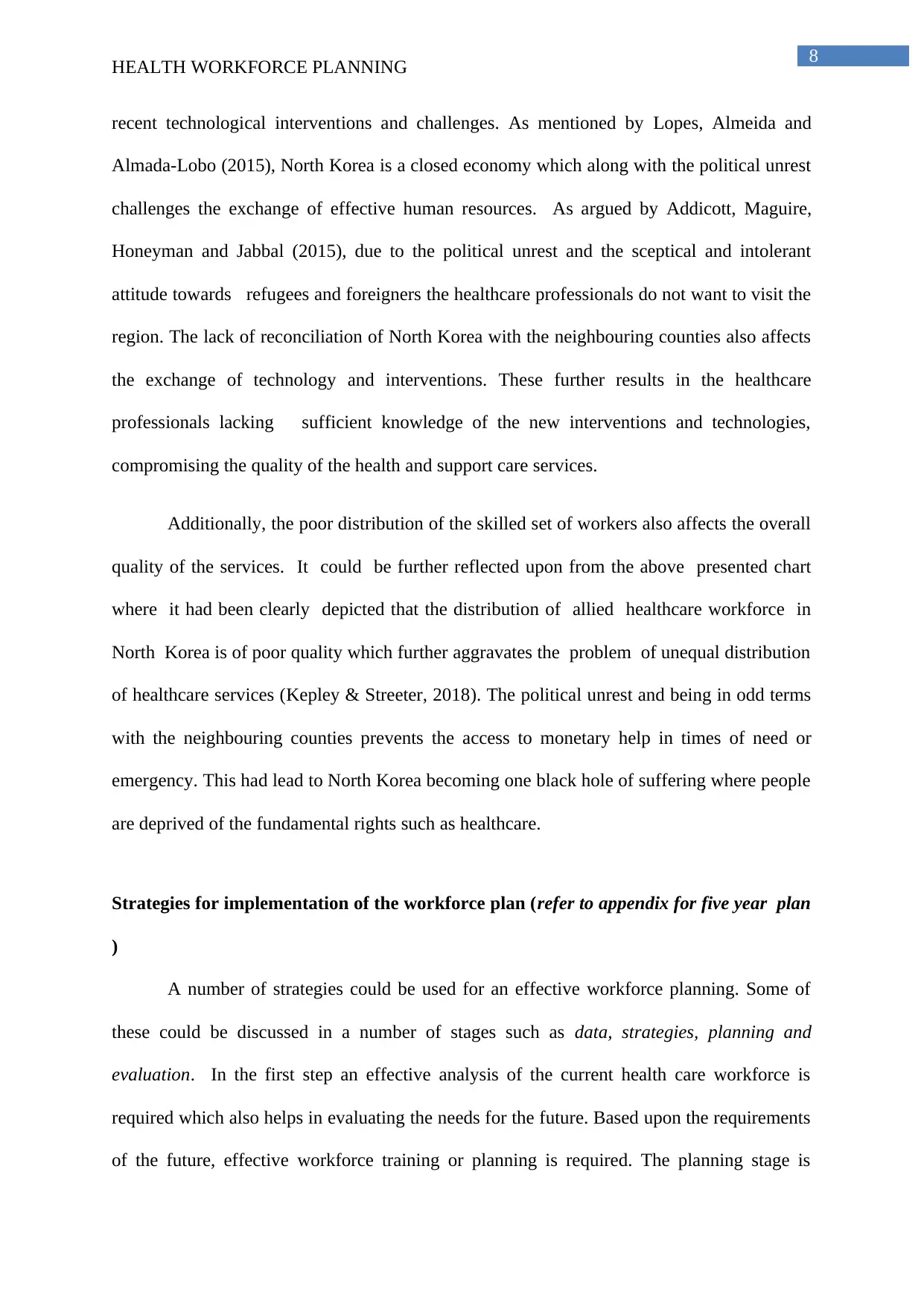
8
HEALTH WORKFORCE PLANNING
recent technological interventions and challenges. As mentioned by Lopes, Almeida and
Almada-Lobo (2015), North Korea is a closed economy which along with the political unrest
challenges the exchange of effective human resources. As argued by Addicott, Maguire,
Honeyman and Jabbal (2015), due to the political unrest and the sceptical and intolerant
attitude towards refugees and foreigners the healthcare professionals do not want to visit the
region. The lack of reconciliation of North Korea with the neighbouring counties also affects
the exchange of technology and interventions. These further results in the healthcare
professionals lacking sufficient knowledge of the new interventions and technologies,
compromising the quality of the health and support care services.
Additionally, the poor distribution of the skilled set of workers also affects the overall
quality of the services. It could be further reflected upon from the above presented chart
where it had been clearly depicted that the distribution of allied healthcare workforce in
North Korea is of poor quality which further aggravates the problem of unequal distribution
of healthcare services (Kepley & Streeter, 2018). The political unrest and being in odd terms
with the neighbouring counties prevents the access to monetary help in times of need or
emergency. This had lead to North Korea becoming one black hole of suffering where people
are deprived of the fundamental rights such as healthcare.
Strategies for implementation of the workforce plan (refer to appendix for five year plan
)
A number of strategies could be used for an effective workforce planning. Some of
these could be discussed in a number of stages such as data, strategies, planning and
evaluation. In the first step an effective analysis of the current health care workforce is
required which also helps in evaluating the needs for the future. Based upon the requirements
of the future, effective workforce training or planning is required. The planning stage is
HEALTH WORKFORCE PLANNING
recent technological interventions and challenges. As mentioned by Lopes, Almeida and
Almada-Lobo (2015), North Korea is a closed economy which along with the political unrest
challenges the exchange of effective human resources. As argued by Addicott, Maguire,
Honeyman and Jabbal (2015), due to the political unrest and the sceptical and intolerant
attitude towards refugees and foreigners the healthcare professionals do not want to visit the
region. The lack of reconciliation of North Korea with the neighbouring counties also affects
the exchange of technology and interventions. These further results in the healthcare
professionals lacking sufficient knowledge of the new interventions and technologies,
compromising the quality of the health and support care services.
Additionally, the poor distribution of the skilled set of workers also affects the overall
quality of the services. It could be further reflected upon from the above presented chart
where it had been clearly depicted that the distribution of allied healthcare workforce in
North Korea is of poor quality which further aggravates the problem of unequal distribution
of healthcare services (Kepley & Streeter, 2018). The political unrest and being in odd terms
with the neighbouring counties prevents the access to monetary help in times of need or
emergency. This had lead to North Korea becoming one black hole of suffering where people
are deprived of the fundamental rights such as healthcare.
Strategies for implementation of the workforce plan (refer to appendix for five year plan
)
A number of strategies could be used for an effective workforce planning. Some of
these could be discussed in a number of stages such as data, strategies, planning and
evaluation. In the first step an effective analysis of the current health care workforce is
required which also helps in evaluating the needs for the future. Based upon the requirements
of the future, effective workforce training or planning is required. The planning stage is
⊘ This is a preview!⊘
Do you want full access?
Subscribe today to unlock all pages.

Trusted by 1+ million students worldwide
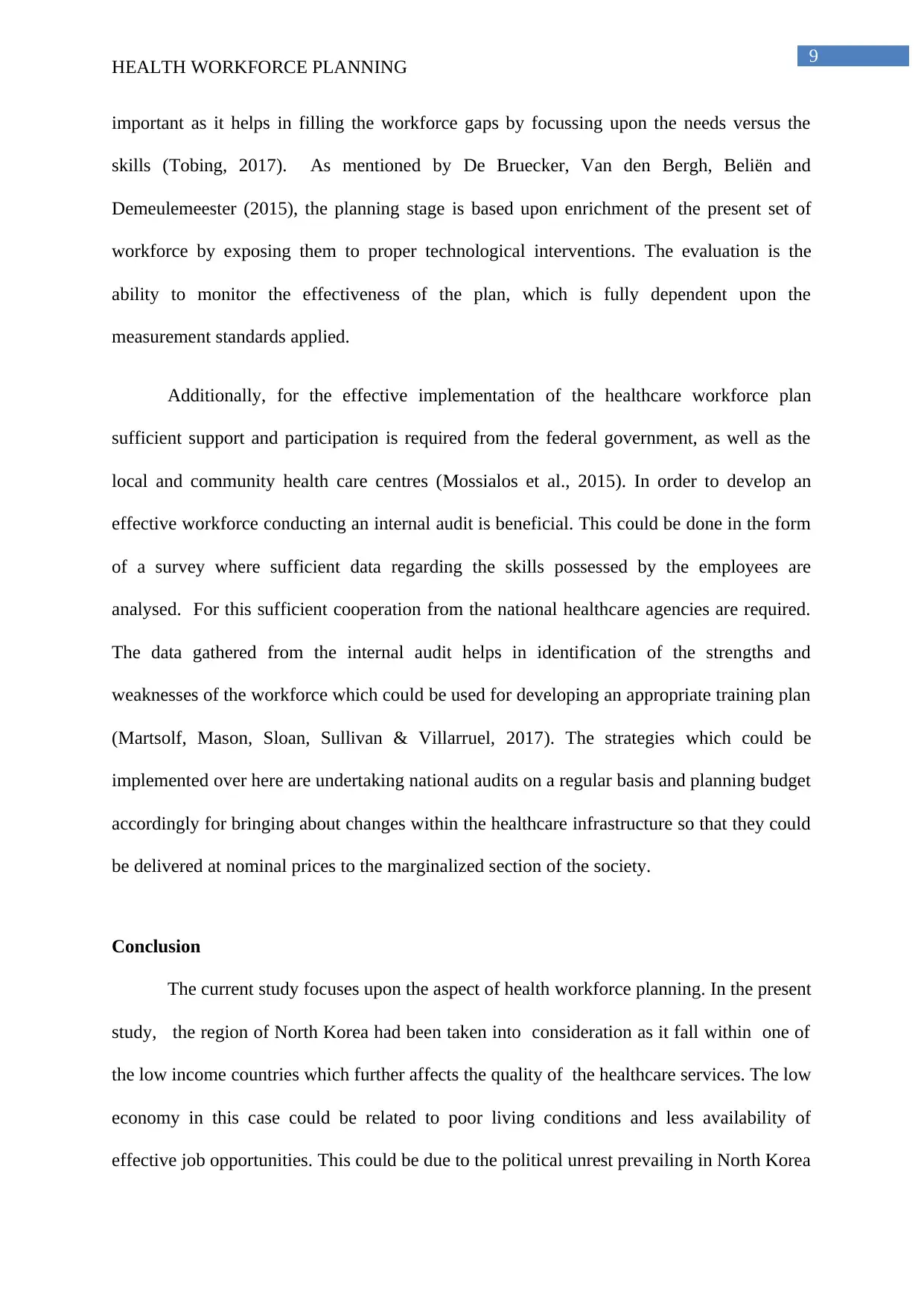
9
HEALTH WORKFORCE PLANNING
important as it helps in filling the workforce gaps by focussing upon the needs versus the
skills (Tobing, 2017). As mentioned by De Bruecker, Van den Bergh, Beliën and
Demeulemeester (2015), the planning stage is based upon enrichment of the present set of
workforce by exposing them to proper technological interventions. The evaluation is the
ability to monitor the effectiveness of the plan, which is fully dependent upon the
measurement standards applied.
Additionally, for the effective implementation of the healthcare workforce plan
sufficient support and participation is required from the federal government, as well as the
local and community health care centres (Mossialos et al., 2015). In order to develop an
effective workforce conducting an internal audit is beneficial. This could be done in the form
of a survey where sufficient data regarding the skills possessed by the employees are
analysed. For this sufficient cooperation from the national healthcare agencies are required.
The data gathered from the internal audit helps in identification of the strengths and
weaknesses of the workforce which could be used for developing an appropriate training plan
(Martsolf, Mason, Sloan, Sullivan & Villarruel, 2017). The strategies which could be
implemented over here are undertaking national audits on a regular basis and planning budget
accordingly for bringing about changes within the healthcare infrastructure so that they could
be delivered at nominal prices to the marginalized section of the society.
Conclusion
The current study focuses upon the aspect of health workforce planning. In the present
study, the region of North Korea had been taken into consideration as it fall within one of
the low income countries which further affects the quality of the healthcare services. The low
economy in this case could be related to poor living conditions and less availability of
effective job opportunities. This could be due to the political unrest prevailing in North Korea
HEALTH WORKFORCE PLANNING
important as it helps in filling the workforce gaps by focussing upon the needs versus the
skills (Tobing, 2017). As mentioned by De Bruecker, Van den Bergh, Beliën and
Demeulemeester (2015), the planning stage is based upon enrichment of the present set of
workforce by exposing them to proper technological interventions. The evaluation is the
ability to monitor the effectiveness of the plan, which is fully dependent upon the
measurement standards applied.
Additionally, for the effective implementation of the healthcare workforce plan
sufficient support and participation is required from the federal government, as well as the
local and community health care centres (Mossialos et al., 2015). In order to develop an
effective workforce conducting an internal audit is beneficial. This could be done in the form
of a survey where sufficient data regarding the skills possessed by the employees are
analysed. For this sufficient cooperation from the national healthcare agencies are required.
The data gathered from the internal audit helps in identification of the strengths and
weaknesses of the workforce which could be used for developing an appropriate training plan
(Martsolf, Mason, Sloan, Sullivan & Villarruel, 2017). The strategies which could be
implemented over here are undertaking national audits on a regular basis and planning budget
accordingly for bringing about changes within the healthcare infrastructure so that they could
be delivered at nominal prices to the marginalized section of the society.
Conclusion
The current study focuses upon the aspect of health workforce planning. In the present
study, the region of North Korea had been taken into consideration as it fall within one of
the low income countries which further affects the quality of the healthcare services. The low
economy in this case could be related to poor living conditions and less availability of
effective job opportunities. This could be due to the political unrest prevailing in North Korea
Paraphrase This Document
Need a fresh take? Get an instant paraphrase of this document with our AI Paraphraser
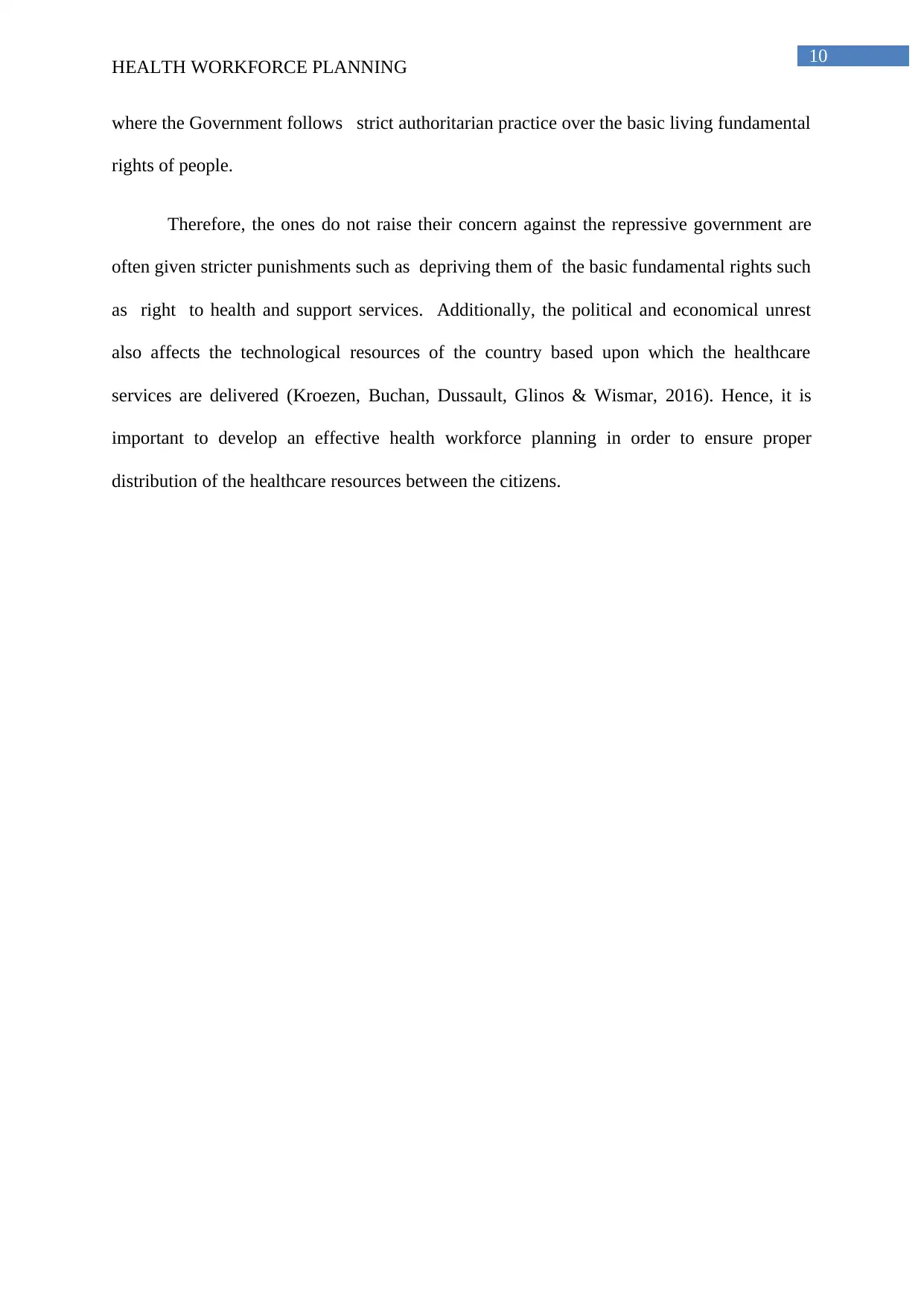
10
HEALTH WORKFORCE PLANNING
where the Government follows strict authoritarian practice over the basic living fundamental
rights of people.
Therefore, the ones do not raise their concern against the repressive government are
often given stricter punishments such as depriving them of the basic fundamental rights such
as right to health and support services. Additionally, the political and economical unrest
also affects the technological resources of the country based upon which the healthcare
services are delivered (Kroezen, Buchan, Dussault, Glinos & Wismar, 2016). Hence, it is
important to develop an effective health workforce planning in order to ensure proper
distribution of the healthcare resources between the citizens.
HEALTH WORKFORCE PLANNING
where the Government follows strict authoritarian practice over the basic living fundamental
rights of people.
Therefore, the ones do not raise their concern against the repressive government are
often given stricter punishments such as depriving them of the basic fundamental rights such
as right to health and support services. Additionally, the political and economical unrest
also affects the technological resources of the country based upon which the healthcare
services are delivered (Kroezen, Buchan, Dussault, Glinos & Wismar, 2016). Hence, it is
important to develop an effective health workforce planning in order to ensure proper
distribution of the healthcare resources between the citizens.
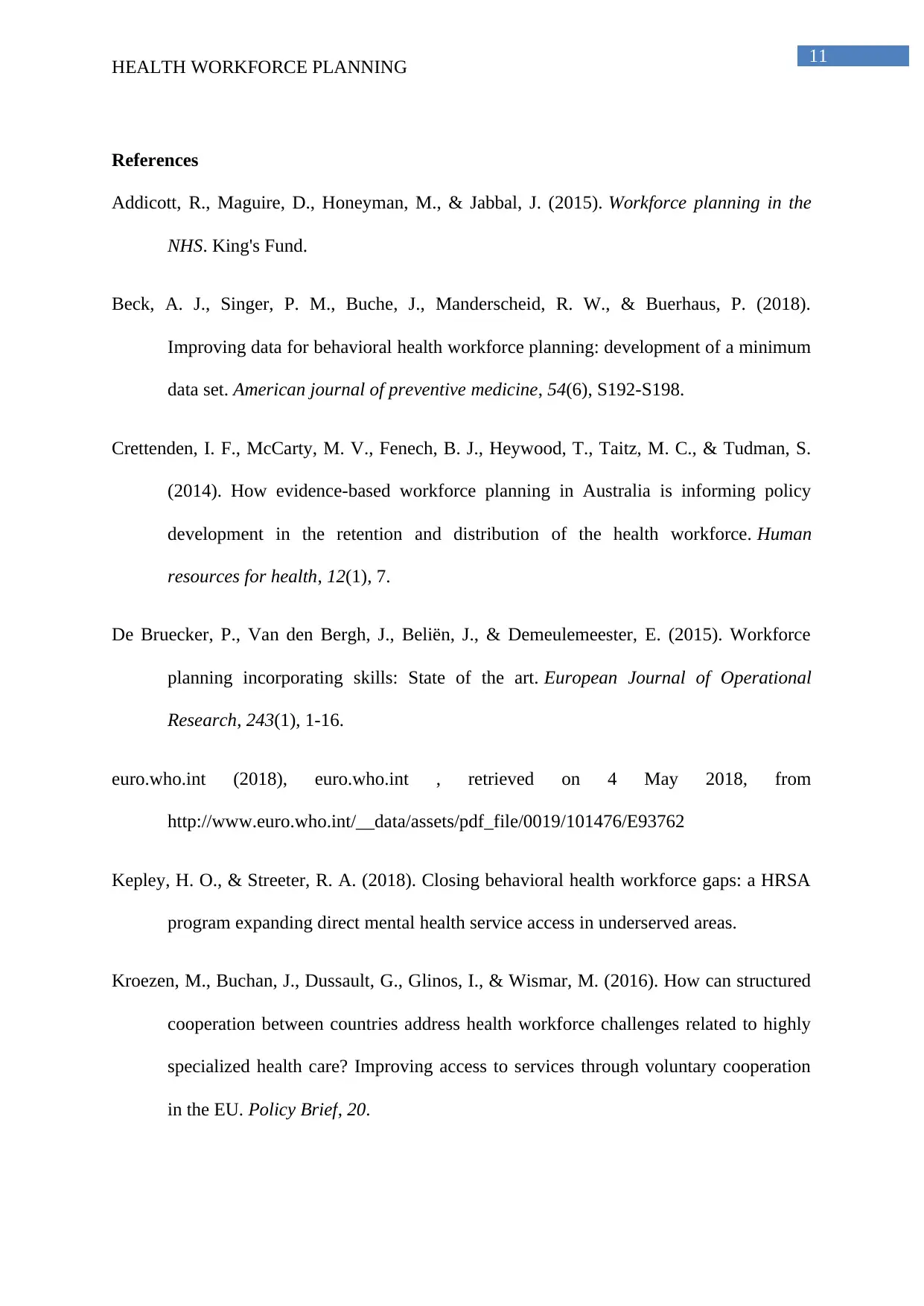
11
HEALTH WORKFORCE PLANNING
References
Addicott, R., Maguire, D., Honeyman, M., & Jabbal, J. (2015). Workforce planning in the
NHS. King's Fund.
Beck, A. J., Singer, P. M., Buche, J., Manderscheid, R. W., & Buerhaus, P. (2018).
Improving data for behavioral health workforce planning: development of a minimum
data set. American journal of preventive medicine, 54(6), S192-S198.
Crettenden, I. F., McCarty, M. V., Fenech, B. J., Heywood, T., Taitz, M. C., & Tudman, S.
(2014). How evidence-based workforce planning in Australia is informing policy
development in the retention and distribution of the health workforce. Human
resources for health, 12(1), 7.
De Bruecker, P., Van den Bergh, J., Beliën, J., & Demeulemeester, E. (2015). Workforce
planning incorporating skills: State of the art. European Journal of Operational
Research, 243(1), 1-16.
euro.who.int (2018), euro.who.int , retrieved on 4 May 2018, from
http://www.euro.who.int/__data/assets/pdf_file/0019/101476/E93762
Kepley, H. O., & Streeter, R. A. (2018). Closing behavioral health workforce gaps: a HRSA
program expanding direct mental health service access in underserved areas.
Kroezen, M., Buchan, J., Dussault, G., Glinos, I., & Wismar, M. (2016). How can structured
cooperation between countries address health workforce challenges related to highly
specialized health care? Improving access to services through voluntary cooperation
in the EU. Policy Brief, 20.
HEALTH WORKFORCE PLANNING
References
Addicott, R., Maguire, D., Honeyman, M., & Jabbal, J. (2015). Workforce planning in the
NHS. King's Fund.
Beck, A. J., Singer, P. M., Buche, J., Manderscheid, R. W., & Buerhaus, P. (2018).
Improving data for behavioral health workforce planning: development of a minimum
data set. American journal of preventive medicine, 54(6), S192-S198.
Crettenden, I. F., McCarty, M. V., Fenech, B. J., Heywood, T., Taitz, M. C., & Tudman, S.
(2014). How evidence-based workforce planning in Australia is informing policy
development in the retention and distribution of the health workforce. Human
resources for health, 12(1), 7.
De Bruecker, P., Van den Bergh, J., Beliën, J., & Demeulemeester, E. (2015). Workforce
planning incorporating skills: State of the art. European Journal of Operational
Research, 243(1), 1-16.
euro.who.int (2018), euro.who.int , retrieved on 4 May 2018, from
http://www.euro.who.int/__data/assets/pdf_file/0019/101476/E93762
Kepley, H. O., & Streeter, R. A. (2018). Closing behavioral health workforce gaps: a HRSA
program expanding direct mental health service access in underserved areas.
Kroezen, M., Buchan, J., Dussault, G., Glinos, I., & Wismar, M. (2016). How can structured
cooperation between countries address health workforce challenges related to highly
specialized health care? Improving access to services through voluntary cooperation
in the EU. Policy Brief, 20.
⊘ This is a preview!⊘
Do you want full access?
Subscribe today to unlock all pages.

Trusted by 1+ million students worldwide
1 out of 14
Related Documents
Your All-in-One AI-Powered Toolkit for Academic Success.
+13062052269
info@desklib.com
Available 24*7 on WhatsApp / Email
![[object Object]](/_next/static/media/star-bottom.7253800d.svg)
Unlock your academic potential
Copyright © 2020–2025 A2Z Services. All Rights Reserved. Developed and managed by ZUCOL.




